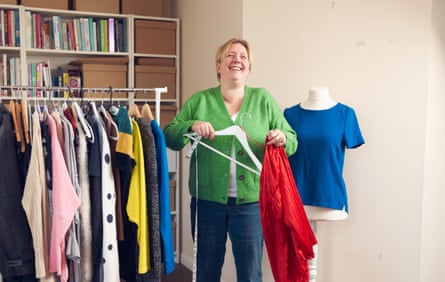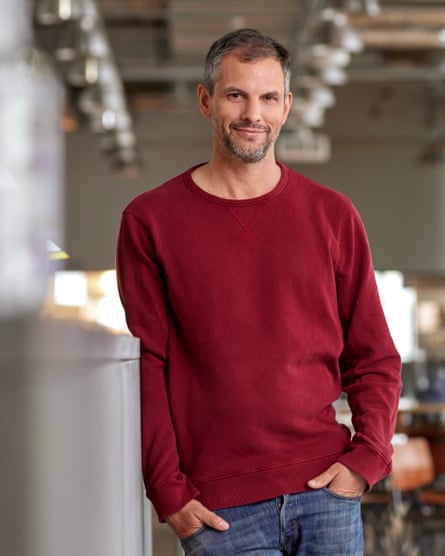
When is a jumble sale also a billion-euro tech startup? When it has 500m items for sale and 105 million users.
I am in Vilnius, Lithuania, at the headquarters of Vinted, the slick, easy-to-use app where users can buy and sell secondhand clothes, shoes and gadgets. If you haven’t used Vinted yet, you certainly know someone who has. In the UK, it has an astonishing 16 million users – nearly one-quarter of the population – and is taking on more established rivals, including Depop and eBay.
I am one of them. I write this article in a pair of black Aeyde boots, bought from Vinted for £45 (RRP £325), with a Rejina Pyo coat, bought from Vinted for £168 (RRP £795), slung over the back of my chair. My son, meanwhile, is dressed today exclusively in Vinted: a coat for £5, a sleepsuit I bought as a “bundle” of three for £3. The pricing is absurdly attractive, but it’s also the pleasurable treasure-hunt thrill of searching the app for a bargain that keeps me coming back.
“The genius of it is the delivery,” says Melanie Monchar, a 52-year-old admin worker from Portishead in North Somerset, who sells clothes on the app. “That’s why I switched from eBay to Vinted. Because when you have to buy postage and work it all out, it’s a headache.” Vinted generates an in-app postage label, which can be used to drop off or collect items from newsagents or lockers. Plus, unlike eBay, there are no seller fees and no fiddly categories to fill in before you can list an item. Because there’s a ban on photos from store websites of the clothing being modelled, you feel like what you are buying is more authentic. (The same rules do not apply on Depop or eBay, which typically have more professional – and expensive – resellers.)
Since joining the app two years ago, Monchar has made £800, mostly from selling her daughter’s old clothes. “I like the money I get from it, but it’s more that I feel so terrible about chucking stuff away,” she says. “To be able to sell things on that haven’t been worn very much, and are still full of life, is amazing.”
“Our mission is to make secondhand the first choice globally,” says Vinted’s CEO, Adam Jay, with the evangelising zeal of a headset-wearing pastor of a megachurch. Jay, who is British, is clad almost entirely in items bought on Vinted – only his socks (a gift) and battered trainers were bought from a shop. He pulls up his Vinted account to show me his reviews. (All Vinted users are reviewed by the people they buy from and sell to.) “Five stars all the way,” he says. I ask how much he paid for his sweatshirt. He consults the app, before laughing nervously. “I got a £5 discount,” he says. “I paid £15; it was on for £20.” Users can make lower offers in the app.
Vinted is Lithuania’s first “unicorn” (tech speak for a private startup with a valuation of at least $1bn). But I could be talking to Jay at any startup the world over. The aesthetic here is Bay Area, the vibe ostentatiously casual. In the bustling canteen, workers in denim and flannel shirts eat avocado toast. Everyone is young and multi-gadgeted: MacBooks under arms, AirPods in ears, taking conference calls while simultaneously tapping away on smartphones. There are nap rooms; a games room with PlayStations; a music room with guitars, for any impromptu jam sessions workers might desire; and, for reasons that remain obscure, swings.

Although Vinted launched in the UK in 2014, the platform started to generate traction in 2021. It was “classic pandemic behaviour to clean out your wardrobes,” says Jay. By 2022, Vinted was being used by 8 million Britons. The following year, that doubled.
For consumers such as Monchar, buying new clothes seems increasingly ethically indefensible in a world overflowing with stuff. According to research commissioned by Vinted, 39% of transactions on the platform prevented the purchase of a new item. But could Vinted kill fast fashion? “I don’t think it’s penetrated sufficiently to disrupt fast fashion as an industry,” says Dr Elaine Ritch, an expert in fashion-consumer behaviour at Glasgow Caledonian University. “It’s such an entrenched model and retailers are so clever at using marketing tactics to encourage that frequent compulsion.”
However, Ritch believes that Vinted can appeal to a cohort of young consumers who might otherwise be drawn to fast fashion. “A lot of what fast fashion retailers sell is very homogenised,” she says. “People who want more of an individualistic style move towards secondhand fashion.”
When the academic Dr Isabel Palomo Dominguez focus-grouped Vinted users for a 2023 research project, she found many used Vinted because “they were bored of the typical clothes you can buy in regular stores”.
This is also the appeal for Arjun Gossain, 26, a civil engineer from Reading. “You just get much more of an array of stuff,” he says. Gossain has always been into fashion, but before Vinted he would buy items from high street stores such as Zara and H&M. “I felt a bit stuck, like I had no other option,” he says. “This is the only stuff I can afford. But it kept breaking or shrinking, so I had to buy another. It was a bit of a cycle.” Now he buys items from more expensive brands, such as Dickies, Carhartt and Levi’s, through Vinted, for the same price as fast fashion.

As we speak, he rummages through his wardrobe, pulling out his favourite Vinted find: a forest-green Levi’s jacket that his partner bought him for £37. “It’s just built to last,” he says. “I can’t see it ripping in a few months – and if it did, I’d get it repaired, because I like it so much.”
But Vinted isn’t a no-guilt shopping solution. There is an environmental cost every time a parcel thuds through a letterbox, even if it’s less damaging than buying new. According to McKinsey, road freight accounts for 15% of Europe’s CO2 emissions. The so-called “last mile” of delivery, when parcels move from a local hub to front doors, is particularly polluting. “We can criticise the fact that it’s delivered, and there’s mileage in that, and the couriers might be working for the gig economy … but if something is getting worn and used by more than one person, that is more of what we need,” says Ritch. “We need to make the most of the resources already in circulation.”
Perhaps Vinted’s legacy will be to rebrand secondhand shopping not only as socially acceptable, but aspirational. Vinted’s co-founder Milda Mitkute says that, for her parents in Soviet Lithuania, “you bought secondhand because you didn’t have money”. In the post-Soviet era, Mitkute was the first member of her family to travel through Europe and participate in Lithuania’s new consumer culture. “Clothing was my expression,” she says. Mitkute laughs as she remembers how her bursting wardrobe lurched from “bling-bling style to goth”.
In 2008, Mitkute, then 22, was at a house party when she bumped into Justas Janauskas, an old friend who had programming experience. Mitkute told him that she was moving house and wanted to clear out her closet. Two weeks later, they launched a website to sell 100 items of Mitkute’s clothing. It was an amateur effort; initially, they forgot to include a “buy” button.
Lithuania is a small country, so word quickly got out. Vinted grew exponentially, but it wasn’t making any money; Mitkute and Janauskas could barely afford their server bills. In 2011, the Lithuanian businessman Mantas Mikuckas came on board as an angel investor. “He said: ‘Guys, do you understand what you have created?’” Mitkute remembers. “We said: ‘Yes, it’s a platform for girls to sell items.’ He said: ‘No. It’s much bigger.’” Vinted is now backed by a number of venture capital funds and Mitkute is a household name in Lithuania.
We are having our conversation in a glass-walled meeting room. Every few minutes, Mitkute smiles and waves at passing staff. But she is no longer employed by the unicorn she co-founded. When she had her first child, seven years ago, she went on maternity leave and chose not to return. Having kids and Vinted was “an impossible thing”, she says. “Because Vinted is a big, big child. As much time as you’re going to give to Vinted, it’s going to take.” She has a financial stake in the company, but is not on the board. “It’s very mixed feelings,” she says.
Vinted’s journey from student project to an international operation that employs more than 1,800 people has proved fraught. Its annus horribilis was 2016: the company closed four offices and cut staff. “It was a tumultuous year,” says Jay. “We changed a lot of things about the business model.” One crucial decision was to remove seller fees. They also developed the app’s in-built shipping functionality. “Those things really got lift off,” he says.
But Vinted is not yet profitable: it posted a pre-tax loss in 2022 of €47.1m (£40m). In October, the FT reported a possible share sale before an IPO. All Jay will say, with a tight smile, is that “profitability will come”. Ultimately, he has to deliver returns for Vinted’s investors. Could he foresee a situation in which Vinted’s financial and sustainable goals conflict? “We honestly don’t have this trade off, because the two things are so deliciously hand in glove,” he says.
I ask whether Vinted plans to certify as a B Corp – a commercial business recognised for its social impact – given the company’s lofty goals. “The important thing is that we have a real impact on sustainability, whether or not we have the badge of a B Corp,” he says.
In the UK, Jay’s mission may be made more difficult by HMRC, which from 1 January will tax profits of more than £1,000 a year on sales made through platforms such as Vinted and eBay. Some users have said that the “side-hustle tax” may make reselling garments online more effort than it’s worth.
Jay also has the unenviable task of overseeing a team of 300 in-house and 2,000 outsourced support workers, whose job it is to resolve disputes between buyers and sellers. There is a “name and shame Facebook group” for bad buyers and sellers, says Monchar, “which is like a soap opera”.
Vinted charges buyers a fee of between 3% and 8% of an item’s price. In exchange, buyers are assured that if they receive an item that is significantly not as described, they will get a refund, provided they contact customer service within two days of delivery. (After that, the order automatically closes.)
The No 1 gripe Vinted users have with the platform is that even if an item isn’t listed correctly, buyers have to pay for returns, unless the seller agrees otherwise. “It’s the principle of it,” says Tamara Newton, 28, a student from Darwen, Lancashire. She recently bought a pair of trainers for £15. They were listed as in good condition; however, when the trainers arrived, “the smell was horrendous as soon as I opened the box”. She requested a refund, but Vinted support told Newton that she would have to pay for return postage. “The seller broke Vinted’s terms and conditions, but the consumer is the one who has to pay for the return,” she says. “It put a sour taste in my mouth,” Newton says. She closed her account.
“If something is flagged, then we will investigate and try to arbitrate in the fairest possible way between the buyer and seller,” says Jay. But it seems instinctively unfair that buyers should end up out of pocket when the seller is at fault.
Disputes are the platform’s curse, or main appeal, depending on how you look at it. The Instagram account @DMDrama documents fraught and often hilarious Vinted interactions to its 617,000 followers. Highlights include a potential buyer who offered 17p for a single pair of baby socks, a user who found a piece of broccoli in a pair of shoes and a pair locked in a tense six-page message thread over a minuscule stain on a £1.50 top. The worst offenders, says @DMDrama’s anonymous founder, whom we will call Tom, are “the Y2K girlies who love Brandy Melville – they’re very sassy”, or “the streetwear cool kids who get loads of money from mum and dad to spend on Supreme”.
His experience moderating the account has taught him that “internet culture is absolutely wild”. He describes the lies, so frequent and unoriginal. “Someone has died, or something to do with hospitals” are frequent excuses for not posting items on time – as are women claiming to be in labour. Once, says Tom, someone messaged a seller pretending to be Steve McFadden, the actor who plays Phil Mitchell on EastEnders, asking for a discount. “I do see some of these stories,” Jay says, laughing. “They get sent around internally.”
But still, there is a serious message here. Up to 73% of all clothing manufactured globally ends up in landfill or is incinerated. Vinted alone cannot break the chokehold of this industry, but it is a start. “We are still so early in this journey of making secondhand the first choice,” says Jay. “It’s still a very small proportion of overall consumption. That’s the thing that keeps me up at night. That’s what motivates me.”



